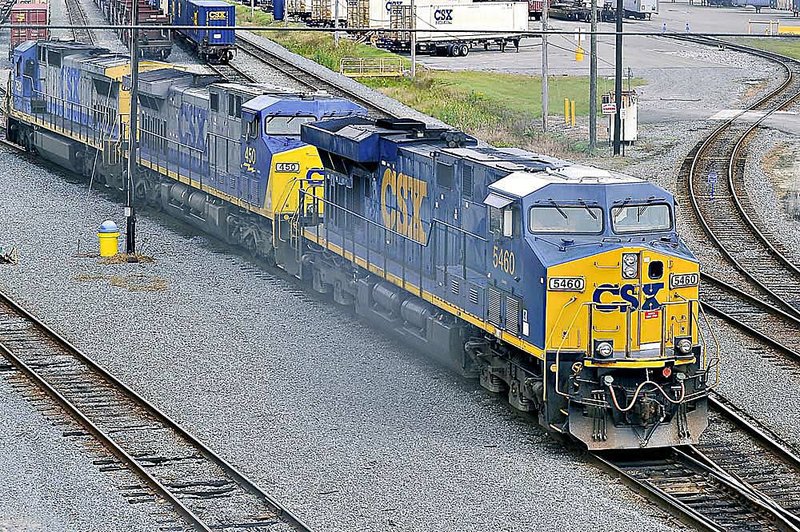LITTLE ROCK — U.S. railroads have a fuelefficiency advantage over trucking companies that they hope to expand, as they boost investments in technology while truckers must put more of their money into personnel.
Freight railroads such as Union Pacific Corp. are investing in systems that automatically shut off engines under certain conditions and software that coordinates trains’ movements more efficiently.
The trucking industry, working to meet its first ever fuel-efficiency standards, is being forced to divert more spending to attract workers and battle increased competition as more trucks fill U.S. highways.
“Railroads by far are leading the pack in terms of investing in fuel-saving initiatives,” said Walter Spracklin, an analyst with RBC Capital Markets in Toronto. “Driving fuel costs down through lower consumption rates is the focus in every operator I talk to.”
Railroads can move a ton of freight 156 miles to 512 miles on a gallon of fuel, compared with 68 miles to 133 miles for truckers, according to the U.S. Department of Transportation’s Federal Railroad Administration. That edge has become even more crucial as a gallon of diesel fuel rose to more than $3.50 last weekfrom 10 cents in 1970.
The six largest publicly traded U.S. railroads may have an average profit margin of 14 percent in their current fiscal years, up from 12 percent a year earlier, according to analysts’ estimates compiled by Bloomberg. The average profit margin of 20 publicly traded U.S. trucking companies is estimated to widen to 3 percent in 2011 from 0.6 percent in 2010.
Union Pacific, the largest U.S. railroad by revenue, has equipped 70 percent of its 8,350 locomotives with technology that turns off the engine after varying idle times, said Mike Iden, general director of car and locomotive engineering. The process conserves about 167,000 gallons of fuel a day, he said. With diesel at $3.53 a gallon, thedaily savings equal $589,500.
Railroads also use software that coordinates trains on a network, showing conductors and dispatchers where they can run routes more effectively.
Union Pacific, based in Omaha, Neb., last year sped the adoption of staggering engines throughout a train to spread the locomotive power, moving 62 percent of its gross ton miles that way, up from 35 percent in 2008. Distributing power improves trains’ fuel efficiency as much as 6 percent, Iden said.
General Electric Co., which makes locomotives, has developed air-traffic-controlstyle software that manages the 2,500 engines on Norfolk, Va.-based Norfolk Southern Corp.’s network.
Jacksonville, Fla .-basedCSX Corp. uses a software program that tells conductors and dispatchers when, where and how to speed up trains.
“The rails by and large have been investing in more fuel-efficient technology, and also have pricing power,” said Joel Levington, who covers railroads for Brookfield Investment Management Inc. “We expect they will be more profitable than trucking fleets.”
On a scale one to five, where five is a “strong buy” and one is a “strong sell,” the average of analysts’ recommendations for the six largest publicly traded U.S. railroads is 4.22, according to estimates compiled by Bloomberg. The average for 20 publicly traded U.S. trucking companies is 3.8.
The seven Class 1 railroads, including billionaire Warren Buffett’s Burlington Northern Santa Fe, used 5 percent more diesel fuel in 2008 than in 2000, according to the Association of American Railroads. For truckers, diesel consumption rose 16 percent in that same period, according to the American Trucking Association.
Trucking companies such as Lowell-based J.B. Hunt Transport Services Inc. and San Mateo, Calif.-based Conway Inc. will spend $121 billion on 35.6 billion gallons of diesel fuel this year, according to the American Trucking Association. That’s a 5 percent increase in consumptionand a 19 percent gain in cost from the estimated spending in 2010.
Labor has been trucking fleets’ largest operating expense since late 2008, when fuel prices dropped during the recession, Glen Kedzie, the American Trucking Association’s environmental counsel, said in an interview.
Heavy truck fuel-efficiency leveled off at about 6.5 miles per gallon 20 years ago as federal standards forced truckers to invest in making their emissions cleaner, which came at the expense of improving fuel mileage, Kedzie said.
“We’re trying to regain what we lost and then go forward from there,” he said. “As fuel keeps creeping up, it’s going to surpass labor and become No. 1 again.”
The industry may have to adapt to new regulations from the U.S. Environmental Protection Agency, which is proposing a 20 percent increase in fuel efficiency of tractor-trailer trucks by 2018, the first such standards imposed on the industry.
Trucking companies are facing price competition and a shortage of licensed drivers, which is also becoming a cost concern, Kedzie said.
While the number of Class 1 locomotives fell by 15 percent from 1980 to 2008, the supply of trucks on U.S. highways rose 56 percent between 1980 and 2008, according to the Transportation Department.
Business, Pages 64 on 02/27/2011

